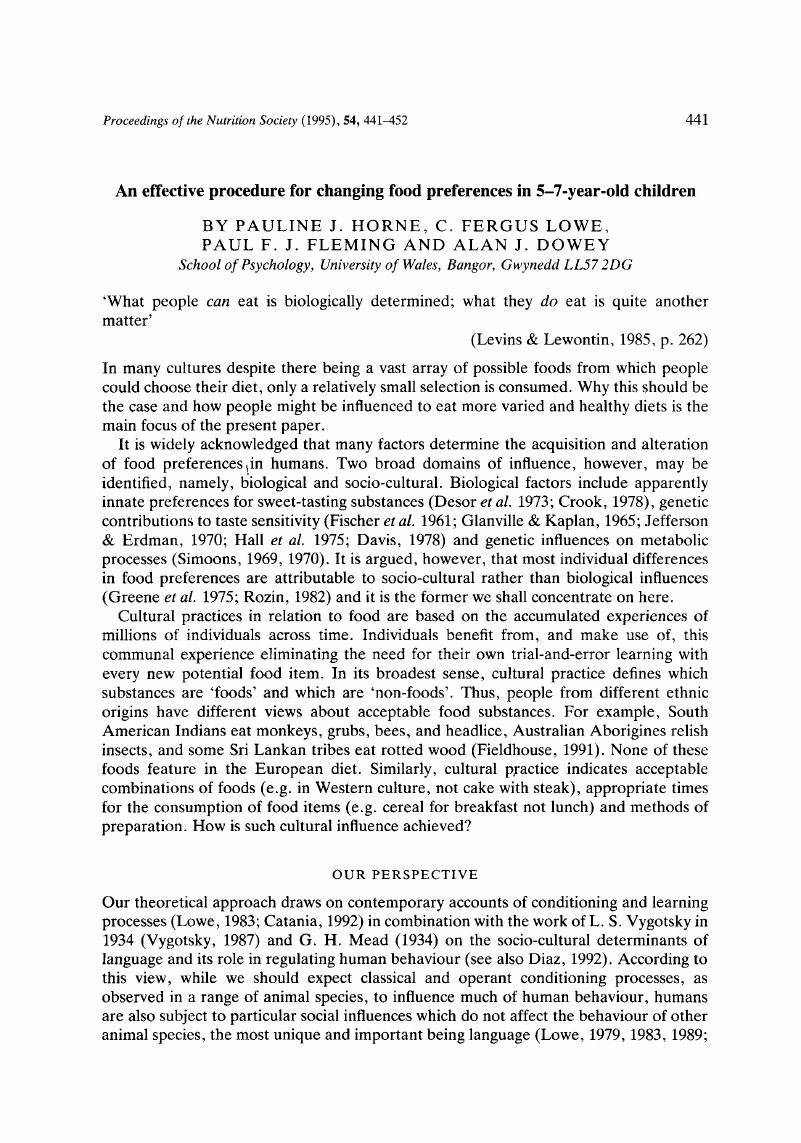Crossref Citations
This article has been cited by the following publications. This list is generated based on data provided by Crossref.
Horne, Pauline J.
Fergus Lowe, C.
Bowdery, Michael
and
Egerton, Christine
1998.
The way to healthy eating for children.
British Food Journal,
Vol. 100,
Issue. 3,
p.
133.
Jansen, A
and
Tenney, N
2001.
Seeing mum drinking a ‘light’ product: is social learning a stronger determinant of taste preference acquisition than caloric conditioning?.
European Journal of Clinical Nutrition,
Vol. 55,
Issue. 6,
p.
418.
Buttriss, Judy
2002.
Nutrition, health and schoolchildren.
Nutrition Bulletin,
Vol. 27,
Issue. 4,
p.
275.
Baghurst, Katrine
2003.
Fruits and Vegetables.
Nutrition Today,
Vol. 38,
Issue. 1,
p.
11.
2003.
Plants: Diet and Health.
p.
302.
Burchett, Helen
2003.
Increasing fruit and vegetable consumption among British primary schoolchildren: a review.
Health Education,
Vol. 103,
Issue. 2,
p.
99.
DiClemente, Diane F.
and
Hantula, Donald A.
2003.
Applied behavioral economics and consumer choice.
Journal of Economic Psychology,
Vol. 24,
Issue. 5,
p.
589.
Wardle, J
Herrera, M-L
Cooke, L
and
Gibson, E L
2003.
Modifying children's food preferences: the effects of exposure and reward on acceptance of an unfamiliar vegetable.
European Journal of Clinical Nutrition,
Vol. 57,
Issue. 2,
p.
341.
Liem, Djin Gie
Mars, Monica
and
De Graaf, Cees
2004.
Sweet preferences and sugar consumption of 4- and 5-year-old children: role of parents.
Appetite,
Vol. 43,
Issue. 3,
p.
235.
Lowe, C F
Horne, P J
Tapper, K
Bowdery, M
and
Egerton, C
2004.
Effects of a peer modelling and rewards-based intervention to increase fruit and vegetable consumption in children.
European Journal of Clinical Nutrition,
Vol. 58,
Issue. 3,
p.
510.
Horne, P J
Tapper, K
Lowe, C F
Hardman, C A
Jackson, M C
and
Woolner, J
2004.
Increasing children's fruit and vegetable consumption: a peer-modelling and rewards-based intervention.
European Journal of Clinical Nutrition,
Vol. 58,
Issue. 12,
p.
1649.
Buttriss, J.
Stanner, S.
McKevith, B.
Nugent, A. P
Kelly, C.
Phillips, F.
and
Theobald, H. E.
2004.
Successful ways to modify food choice: lessons from the literature.
Nutrition Bulletin,
Vol. 29,
Issue. 4,
p.
333.
Blake, Anthony A.
2004.
Flavor Perception.
p.
172.
Anderson, AS
Porteous, LEG
Foster, E
Higgins, C
Stead, M
Hetherington, M
Ha, M-A
and
Adamson, AJ
2005.
The impact of a school-based nutrition education intervention on dietary intake and cognitive and attitudinal variables relating to fruits and vegetables.
Public Health Nutrition,
Vol. 8,
Issue. 6,
p.
650.
Hendy, Helen M.
Williams, Keith E.
and
Camise, Thomas S.
2005.
“Kids Choice” School lunch program increases children's fruit and vegetable acceptance.
Appetite,
Vol. 45,
Issue. 3,
p.
250.
Knai, Cécile
Pomerleau, Joceline
Lock, Karen
and
McKee, Martin
2006.
Letter to the Editor.
Preventive Medicine,
Vol. 43,
Issue. 4,
p.
352.
Lowe, C. Fergus
Horne, Pauline J.
Hardman, Charlotte A.
and
Tapper, Katy
2006.
A peer-modeling and rewards-based intervention is effective in increasing fruit and vegetable consumption in children.
Preventive Medicine,
Vol. 43,
Issue. 4,
p.
351.
Russell, CG
and
Worsley, A
2007.
Do children's food preferences align with dietary recommendations?.
Public Health Nutrition,
Vol. 10,
Issue. 11,
p.
1223.
Horne, P J
Hardman, C A
Lowe, C F
and
Rowlands, A V
2009.
Increasing children's physical activity: a peer modelling, rewards and pedometer-based intervention.
European Journal of Clinical Nutrition,
Vol. 63,
Issue. 2,
p.
191.
Hardman, Charlotte A.
Horne, Pauline J.
and
Lowe, C. Fergus
2009.
A Home-Based Intervention to Increase Physical Activity in Girls: The Fit ‘n’ Fun Dudes Program.
Journal of Exercise Science & Fitness,
Vol. 7,
Issue. 1,
p.
1.



